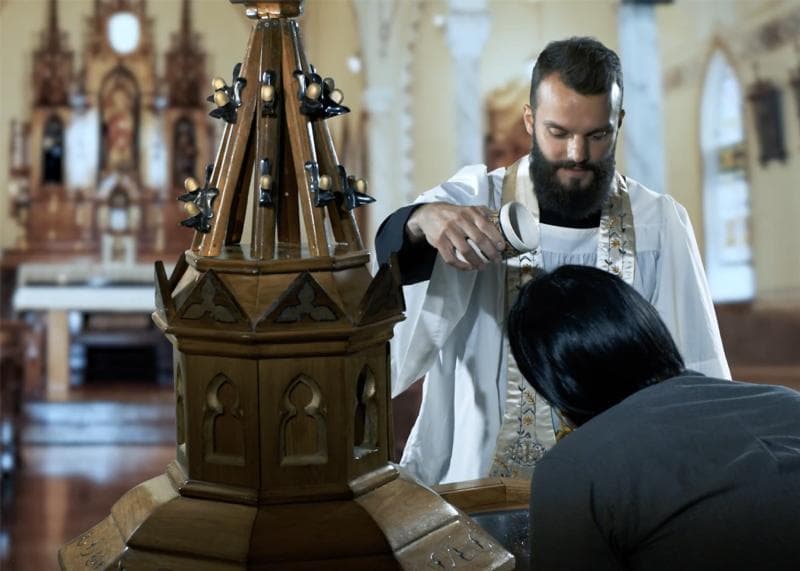SOUTH BEND, Indiana — Sister Judith Ann Zielinski was surprised when she learned a cause for canonization had been opened to consider making Nicholas Black Elk a saint of the Catholic Church.
A Franciscan nun, she knew who Black Elk was because of the 1932 book Black Elk Speaks, by John Neihardt, a poet with an interest in Native American culture.
And that’s why Zielinski was surprised: Black Elk Speaks makes no mention of the Oglala Lakota holy man’s baptism in his 40s and subsequent career as a catechist — teacher of the faith.
“Black Elk has become this symbol of the Great American Indian,” she says, “mourning the loss of the great native culture before the white man came. … The world pictured Black Elk as praying on the mountain, tragically, for this world that was no more.”
That may start to change when a documentary she wrote and produced, “Walking the Good Red Road: Nicholas Black Elk’s Journey to Sainthood,” begins airing nationally today on ABC affiliates.
South Bend’s NewGroup Media, where Zielinski works as the Director of Faith & Values Programming, made the 58-minute film on behalf of the Diocese of Rapid City, South Dakota, which initiated the cause for canonization in 2017.
Neihardt’s book, which enjoyed a revival in popularity during the 1970s, depicted only the first half of Black Elk’s life, in the 19th century and before he was baptized in 1904 and became a catechist who’s now credited with baptizing more than 400 Lakota on the Pine Ridge Reservation in South Dakota.
A brief overview of Black Elk’s life shows why Neihardt made the editorial choices he did: He lived a remarkable life as a young man.
Born Dec. 1, 1863, in pre-reservation America, Black Elk was a cousin of Crazy Horse, participated as a 13-year-old in the Battle of Little Bighorn, toured Europe as a dancer with Buffalo Bill Cody’s “Wild West Show,” survived the Battle of Wounded Knee and served the Lakota as a medicine man.
But his first wife, Katie War Bonnet, converted to Catholicism and they baptized their three children in the Church. After her death in 1903, Black Elk was baptized in 1904 and worked for the next 30 years as a catechist and, to some extent, lay minister who performed many of the non-sacramental duties of a priest, such as visiting the sick.
“My interest in that story was exactly that,” Zielinski says, “this intersection of this Native American man’s life with his Lakota tradition and his life as a Christian, and then his path to sainthood.”
Directed by NewGroup’s Christopher Salvador, “Walking the Good Red Road” includes interviews with scholars who have studied the Lakota and Black Elk; a bishop and priests from the Catholic Church who are familiar with Black Elk’s story; Black Elk’s 86-year-old grandson, George Looks Twice; and Black Elk’s great-great-great grandson, Maka Akan Najin Black Elk.
It also includes interviews with three Lakota with ties to Black Elk: Patricia Catches the Enemy, a Lakota Elder and granddaughter of Pete Catches, a catechist-contemporary of Black Elk; Lakota Elder Basil Brave Heart, who discusses Lakota culture as well as his own childhood memories of seeing Black Elk picking potatoes; and Lakota artist Arthur Amiotte, who attended Black Elk’s funeral as an 8-year old in 1950.
Hundreds of rare historical and archival photos from Marquette University and Jesuit collections give the viewer a glimpse at the world in which Black Elk lived. Salvador also makes use of some vintage audio recordings Father Michael F. Steltenkamp made of one of Black Elk’s daughters, Lucy Black Elk.
The film also includes some re-created scenes, such as the Ghost Dance and Black Elk’s funeral, which was filmed at the church and cemetery where he is buried.
If it happens, Zielinski says, Black Elk’s canonization “would be a recognition that God did holy things among the Lakota long before the missionaries arrived. … There is holiness and dignity in every culture. It does not take colonialism to bring that out and make it like the lives of the colonizers themselves.”
First, however, candidates for sainthood go through four stages: Servant of God, where Black Elk is now as research into his life is conducted; Venerable; Blessed; and Saint. Along the way, two miracles attributed to him must be confirmed by the Vatican.
As she and NewGroup worked on the documentary, Zielinski says, she tried to answer one pivotal question: Why should Black Elk be considered for sainthood?
“I know a lot of people in my circle of friends and acquaintances who have worked as a catechist, and they’re not up for sainthood,” she says. “Why him? What is the driving force behind canonization?”
For her, the answer begins with a vision Black Elk had as a child that he recounted for Neihardt during their interviews in 1930, when he was approximately 66 years old.
“Assuming there was some veracity to that, he has this vision that puts him on the path of the seeker of God, the mystical,” Zielinski says. “He walks around with this calling during this horrible, horrible time in the life of his tribe.”
That included the U.S. government’s forcible relocation of the Lakota onto the Pine Ridge Indian Reservation, the deliberate slaughter of the buffalo that were the tribe’s main source of meat and the Wounded Knee Massacre in 1890.
Black Elk also told Neihardt about a pivotal Ghost Dance during which he saw the world as unified under a single protective tree, with all peoples the product of a single mother and father.
“He goes into this thinking, ‘If we pray hard enough, God will restore nature and bring back all those slain buffalo,’” Zielinski says about the Ghost Dance, which is meant to revive the spirits of the dead, who are then expected to fight on behalf of the living to rid their land of the white colonists and restore their prosperity.
“Of course, that doesn’t happen,” Zielinski says. “But he had this other religious experience in the course of the dance. In his description, he says, ‘I saw the Son of God and this god was not a white man, he was not an Indian. He was the god of all peoples.’ I believe this is the key to Black Elk’s holiness.”
Also, Black Elk had met and befriended Jesuit missionaries who had come to Pine Ridge in the 1880s, and those relationships and memories of the curiosity he felt when he visited cathedrals in Europe, combined with his vision, help to steer him toward Catholicism.
The film does raise the question of whether Black Elk truly converted to Catholicism or if he faked it to get along in the white man’s world, as well as the criticism by some Lakota that he forsook their traditions.
Black Elk “is able to somehow say, ‘I was raised a Lakota. I learned as a Lakota how to pray, how to speak to God, how to please God, and yet here come these Jesuits with their message of Christianity and the Son of God,’” Zielinski says. “Instead of rejecting that, he’s able to embrace it because it fits his vision of God belonging to everybody.”
And in that way, she sees Black Elk as a role model for today’s divided partisan culture.
“I think he is this incredible bridge figure,” Zielinski says, “that he could hold his pipe in one hand and hold his rosary in one hand at the same time. … It’s that trying to listen to and accept and embrace the message and beliefs and philosophy of both sides.”















